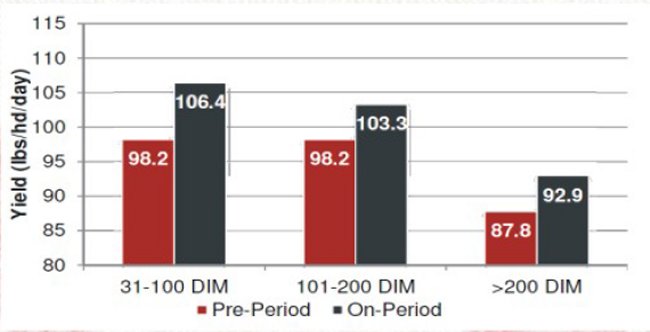
此文件來自 台灣畜產種原知識庫
https://agrkb.angrin.tlri.gov.tw
飼養管理
 |
離氨酸和甲硫氨酸被認為是奶牛日糧對民牛奶合成過程中,典型兩種最常見的限制型必需氨基酸。大多數的推薦顯示於可代謝蛋白質(MetabolizableProtein,MP)中,維持離胺酸對甲硫氨酸3:1的比例可以優化牛奶及其內容成分產量。牧草及其他飼料的變異,以及日糧採食量的改變,變更了可代謝蛋白質供應,導致離氨酸對甲硫氨酸比例及實際供應量的變化。營養模式間的差異預測也創造了目標水準間的差異。這種不確定性是發展過瘤胃而不受破壞的氨基酸其中一個理由;這些產品可以確實地運輸氨基酸至母牛小腸提供吸收及利用。
增加可代謝蛋白離氨酸的水平超過傳統標準的推薦使用量,可以增加泌乳量。許多研究建議增加可利用蛋白離氨酸含量10-15克/每頭/每天,不管是哪個泌乳階段,都可增加乳產量。這個田間示範試驗評估每天補充.45公克過瘤胃離氨酸(離氨酸含量50%)/每頭/每日對民產乳量的影響。補充45公克過瘤胃離氨酸將提供約10g可代謝蛋白離氨酸於日糧中。
材料與方法
此田間示範試驗於一月和二月,在美國賓夕法尼亞州,對100頭荷仕登商用乳牛進行試驗。這些母牛養在畜舍內,每天擠兩次奶。此示範試驗包含了使用前(尚未補充過瘤胃離氨酸)、使用期(補充過瘤胃離氨酸)。因為此群牛對於過瘤胃離氨酸有正向反應,參加此次試驗的農戶要求持續補充過瘤胃離氨酸於日糧中做為常態使用。因此,沒有使用後再停用的數據分析。表佫一比較常規配方裡離氨酸及甲硫氯酸的水平與添加過瘤胃離氨酸後的差異。除了添加過瘤胃離氨酸,日糧組成沒有做其他改變。此日糧包含55%牧草,伴隨著玉米青貯料對苜蓿半乾青貯料2/3:1/3比例,作為完全混合日糧,一天餵飼兩次。這些母牛在做使用期檢測前已採食過瘤胃離氨酸25天。
結果
計算此群牛民試驗前及試驗期的平均乳產量,產後泌乳150天標準乳量及150天能量校正牛乳(ECM)。150天及150天ECM被用來提供一個精準的比較。補充過瘤胃離氨酸期間:
﹒全期,150天和150天ECM乳產量,每天各增加3.7,5.8,1.7磅(圖一)。
﹒整個泌乳期乳產量是增加的。31-100天增加8.2磅,101-200增加5.1磅,200天後增加5.1磅(圖二)。
﹒補充過瘤胃離氨酸期間,所有胎次其150天乳產量都是增加的。初產、二產及經產後泌乳每頭每天各增加6.0、0.8及9.6磅牛乳。
|
【圖一】 |
 |
|
【圖二】 |
 |
|
【圖三】 |
 |
結論:
每頭牛每天補充45公克過瘤胃離氨酸以增加可利用蛋白離氨酸含量約10g,不管是哪個胎次或是哪個泌乳階段,皆能增加乳產量。而在泌乳階段早期(31-100天每日乳量)及三產時期作用效果是最顯著的。
 |
參考文獻:
|
1. |
Rulquin, H, Piselewski PM, Ve'rite' R and Guinard J 1993. Milk production and composition as a function of postruminallysine and methionine supply: a nutrient-response approach. Livestock Production Science 37:69-90. |
|
2. |
Schwab, C.G., L.D. Satter, and A.B. Clay. 1976. Response of lactating dairy cows to abomasal infusion of amino acids. J. Dairy Sci. 59:1254-1270. |
|
3. |
National Research Council 2001. Nutrient Requirements of Dairy Cattle. 7th rev.ed.Natl. Acad. Sci. Washington D.C. |
|
4. |
Aines, G. E., G. F. Schroeder, M. Messman, and M. J. de Veth. 2010. Effects of replacing blood meal with rumen-protected amino acids on milk production and composition in lactating dairy cows. J. Dairy Sci. 93(ESuppl. 1):441. (Abstr.) |
|
5. |
Block, E., E. Evans, and N. Clark. 2010. Supplemental metabolizable lysine delivered with Megamine-Limproves productive performance of lactating cows. J.Dairy Sci. 93(E-Suppl. 1):439. (Abstr.) |
|
6. |
Boucher, S. E., H. M. Dann, K. W.Cotanch, C S. Ballard, R. J. Grant, and I. Shinzato. 2010. Evaluation of a ruminally protected lysine product to increase milk protein production and plasma lysine concentr ation. J. Dairy Sci. 93(E-Suppl. 1):236. (Abstr.) |
|
7. |
Nocek, J. E. and I. Shinzato. 201Oa. The effect of feeding ruminally protected lysine (RPL) on production performance and plasma amino acid profile of early lactation dairy cattle. J. Dairy Sci. 93(E-Suppl. 1) :235. (Abstr.) |
|
8. |
Nocek, J. E., M. Miura, and I. Shinzato. 2010b. The effect of feeding a Prototype of ruminally protected lysine (RPL) on production performance and plasma amino acid profile of early lactation dairy cattle. J. Dairy Sci. 93(E- Suppl. 1):442. (Abstr.) |
|
9. |
Robinson, P. H., S. Juchem, N. Swanepoel, and E. Evans. 2010a. Effects of feeding ruminally protected lysi ne with or without isoleucine,valine, and histidine,to lactating dairy cows nprodu ctive performance and plasma amino acid profiles. J. Dairy Sci. 93 (E-Suppl. 1):450. (Abstr.) |
|
10. |
Robinson, P.H., S. Juchem, and I.Shinzato. 2010b. Productivity of Lactating dairy cows as impacted by feeding lysi ne in a ruminally protected form. J. Dairy Sci. 93(E-Suppl. 1):842. (Abstr.) |
|
11. |
SD-13-00014. Effect of υsing Lysi PEARLto Increase Metabolizable Lysine Protein on Yields of Milk and Milk Components in a Commercial Tie-Stall Dairy in Pennsylvania. |
台灣 林銘湶提供
此文件的網址 :
https://agrkb.angrin.tlri.gov.tw/index.php?page=6733